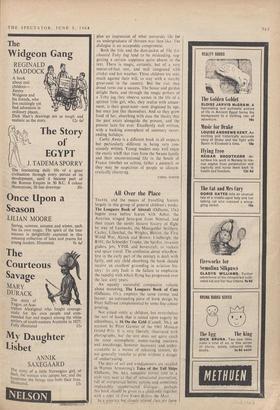All Over the Place
TRAVEL and the means of travelling feature largely in this group of general children's books. The Longacre Book of Aircraft (Odharns, 15s,) begins even before learns with AShur, the Assyrian winged hero-god from Nimrud, and then traces the surely bizarre history of flight by way of Leonardo, the Montgolfier brOthers, Cayley, Lilienthal, the Wrights, Bldriot, the First World War, Alcock and Brown, Lindbergh, the R101, the Schneider Trophy, the Spitfire, invasion gliders, jets, VTOL and hovercraft, to rocket and space travel. The confusion about who-flew- first in the early part of the century is dealt with fairly, and any child absorbing the book should receive an excellent grounding in aviation his- tory.: its only fault is the failure to emphasise the rapidity with which flying has progressed over the last sixty years.
An equally , successful companion volume about motoring, The Longacre Book of Cars (Odhams, 15s.), employs the same format and layout: ,an outstanding piece of book design by Peter Sullivan complemented by some fine colour printing.
Not aimed solely at children, but nevertheless the sort of book that is seized upon eagerly by schoolboys, is 16 On the Grid (Cassell, 30s.), an account by Peter Garnier of the 1963 Monaco Grand Prix. It is very liberally, illustrated, with photographs, but the text does not quite catch the same atmosphere: motor-racing madness and anecdotage, however necessary ,and under- standable as a means of releasing tension, do not generally transfer to print without a danger of embarrassing.
The days of sail and windjaMmers are recalled in Warren Armstrong's Tales of the Tall Ships (Odhams, .10s. 6d.), romantic stories told in a style very near to that of sensational journalism, full of overpraised heroic actions and sometimes implatisibly reconstructed dialogue: perhaps this book should be given to a child only together with a copy of Two Years Before the Most.
In a .epara:e but closely related class arc those
children's books which are basically novels but which manage to incorporate a great deal of information about other countries as well: com- bining the entertaining and the didactic effec- tively make this one of the most difficult kinds of book to write.
In Balloon Journey (Collins, 13s. 6d.) Rene Guillot succeeds admirably with a story of a boy and his grandfather piloting a balloon on a set course round France by means of direc- tional jets, followed on the ground by a mechanic in a huge Lagonda. Line drawings by David Knight add greatly to a book which should delight many children.
Two other stories about France: Gabriel Seal's Adventuring Through France (Macmillan, 16s.) takes two boys in a home-made canoe through rivers and canals from Le Havre to the Mediterranean, and The Chateau Holiday by Winifred Mantle (Gollancz, 13s. 6d.) is a thriller
with a kidnapping, a forest fire, and (naturally) the apprehension of a wrongdoer.
The Golden Goblet (Methuen, 16s.) by Eloise Jarvis McGraw is a well-documented novel set in ancient Egypt, with a young would-be gold- smith as its hero. The travellers in The Voyage to Africa by Marielis Hoberg, translated by R. J. Hollingdale (Abelard-Schuman, 13s. 6d.), are Heiner and Elsie, Hamburg orphans who visit Rotterdam, Lisbon, Seville and Casablanca on their way to foster-parents in Fez. India at the time of the Mutiny forms the background to Tiger Burning Bright by Theodora Du Bois (Gollancz, 15s.), and relates the experiences of a fourteen-year-old American girl and her missionary parents. And lastly, big bumper buy, Let's Visit Europe, by Jean Riverain (Odhams, 16s.), imparts information (together with perhaps unavoidable national clichés) about thirty countries.







































 Previous page
Previous page